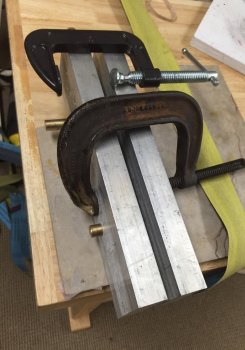You are using an out of date browser. It may not display this or other websites correctly.
You should upgrade or use an alternative browser.
You should upgrade or use an alternative browser.
Quench Plates.
- Thread starter AkWildman
- Start date
SBuzek
Well-Known Member
WOW!!! You sure got big quench plates! The aluminum I ordered was 1X4 -
Ken H>
Mine are 2"X12"X12":biggrin:
Bill Hubbell
KNIFE MAKER
Would someone please educate this newcomer to knifemaking as to the advantages of the quench plates, and with what types of knives or metals they would be most beneficial? I'm thinking it's to control warping? And, is aluminum the best way to go?
Also, AKWildman- do you still have extra, and how much are you asking for it?
Thanks in advance,
Bill
Also, AKWildman- do you still have extra, and how much are you asking for it?
Thanks in advance,
Bill
AkWildman
Well-Known Member
Bill ,you use it with air quenched steel,you take your blade out of the furnace and lay it down on one plate and cover it with the other,it helps with warpage and sucks the heat out of the steel extremely fast.And yes I still have 40 inches left and it's 2.50 per inch plus shipping.
Bill Hubbell
KNIFE MAKER
Thanks for the reply and explanation. I don't think I'll be ready for any air-quenching for awhile. I better focus on building up my shop in other areas of need for now (and skills). But, again, thanks for the reply.
Bill
Bill
2"X12"X12" quench plates? WOW!!! Those are big - that's a chunk of aluminum - and pretty heavy! How do you use them? Clamps? or a press to hold pressure while cooling?
Bill: Yes, quench plates do help on warpage a lot. Place a thin blade between thick plates and clamp it tight, not much chance of warping. The SS I use (Sandvik, and lately AEB-L) are easy bend to straighten by hand as soon as they come out of quench plates. Once they've set a few minutes (or come out of dry ice bath) they do NOT bend!
Ken H>
Bill: Yes, quench plates do help on warpage a lot. Place a thin blade between thick plates and clamp it tight, not much chance of warping. The SS I use (Sandvik, and lately AEB-L) are easy bend to straighten by hand as soon as they come out of quench plates. Once they've set a few minutes (or come out of dry ice bath) they do NOT bend!
Ken H>
scott.livesey
Dealer - Purveyor
quench plates also work on thin oil hardening steel. i have been using it for thin O1, 1/32 and 3/64, quick dip in quench oil, then between quench plates until cold. i am using aluminum plates then weigh them down. anyone have links to plans of clamping quench plates?
Scott, take a look at these plates - they are small at 1"X3"X12". See the brass rods toward bottom? I drop a foil wrapped blade between plates, to rest on brass rods. Then using the C-clamps I hand tighten as much as can. Never really had a problem with warping with blades totally inside plates. Once I had a chef knife where the tang stuck out the end 1" or so and it sure warped.

Ken H>

Ken H>
scott.livesey
Dealer - Purveyor
i was looking for something faster. right now i put blade on bottom plate, add top plate, then big weight or 3. i use plates only for thin stuff, 1/32 to 1/16, not sure of temperature after quick dip in quench oil although blade is black. blades are cool to the touch in less than a minute.Scott, take a look at these plates - they are small at 1"X3"X12". See the brass rods toward bottom? I drop a foil wrapped blade between plates, to rest on brass rods. Then using the C-clamps I hand tighten as much as can. Never really had a problem with warping with blades totally inside plates. Once I had a chef knife where the tang stuck out the end 1" or so and it sure warped.
View attachment 54200
Ken H>
Bruce Bump
Forum Owner-Moderator
quench plates also work on thin oil hardening steel. i have been using it for thin O1, 1/32 and 3/64, quick dip in quench oil, then between quench plates until cold. i am using aluminum plates then weigh them down. anyone have links to plans of clamping quench plates?
I also use them on thin steel immediately after the oil quech. I use my drill press as a press. Simply back off the Chuck jaws so they don't extend down at all and use a 25 pound weight hung from the the drill press handle. One real advantage is no warping.
Frank Niro
KNIFE MAKER
And here I was just the other day wondering if quench plates would help prevent warping if I was using oil hardening steel. Thanks much for this. Now to find locally some aluminum big enough for the job.
Frank
Frank
joe sangster
Well-Known Member
AkWildman ,
Emailed you & sent PM re quench plates but haven't been able to reach .
Joe Sangster
Emailed you & sent PM re quench plates but haven't been able to reach .
Joe Sangster

